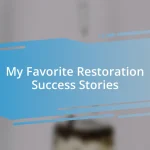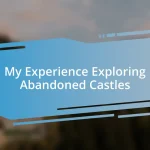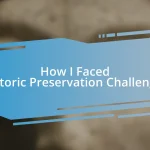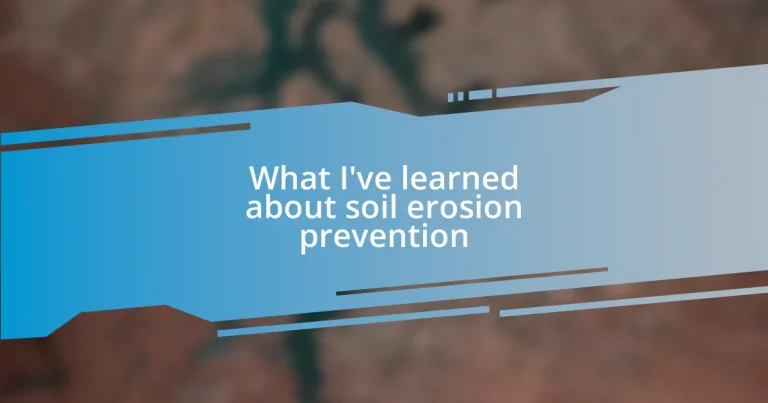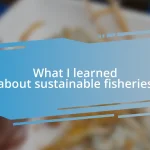Key takeaways:
- Soil erosion is primarily caused by water runoff, wind, and human activities, highlighting the need for sustainable agricultural practices.
- Implementing soil conservation methods, such as cover cropping and contour farming, can significantly enhance soil health, prevent erosion, and promote biodiversity.
- Community engagement in erosion control initiatives fosters local responsibility and enhances environmental stewardship through education and collaborative projects.
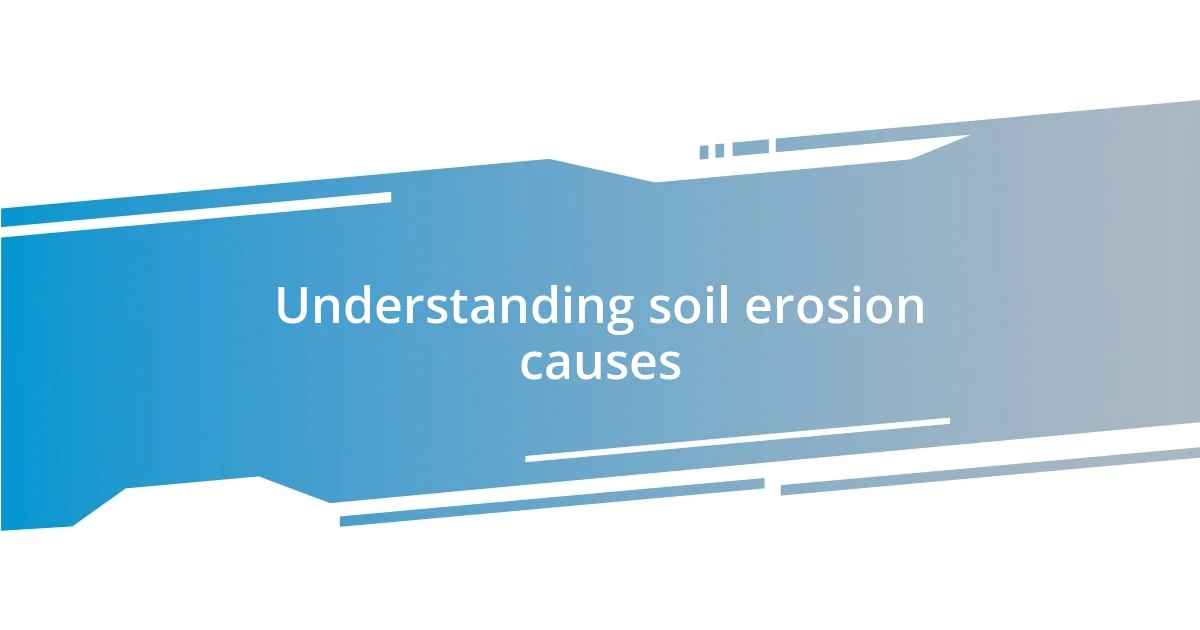
Understanding soil erosion causes
One of the primary causes of soil erosion is water runoff. I remember the time after a heavy rainstorm when I noticed how much topsoil had washed away from my garden. It was disheartening to see the once rich, dark soil reduced to a muddy mess. Have you ever experienced something similar?
Another key factor is wind, which can be surprisingly powerful. I once stood on a windy cliff and watched as gusts swept across the barren landscape, lifting the soil into the air like fine powder. It made me think about how easily vegetation loss—whether from drought, overgrazing, or development—can expose soil to these relentless forces, leaving it vulnerable.
Additionally, human activities play a significant role in accelerating erosion. I often reflect on the farms I’ve visited, where tilling and monocultures stripped the fields of crucial organic matter. It made me question how we can better balance our agricultural practices to protect the soil that sustains us. What changes can we implement in our daily lives or communities to combat this issue?
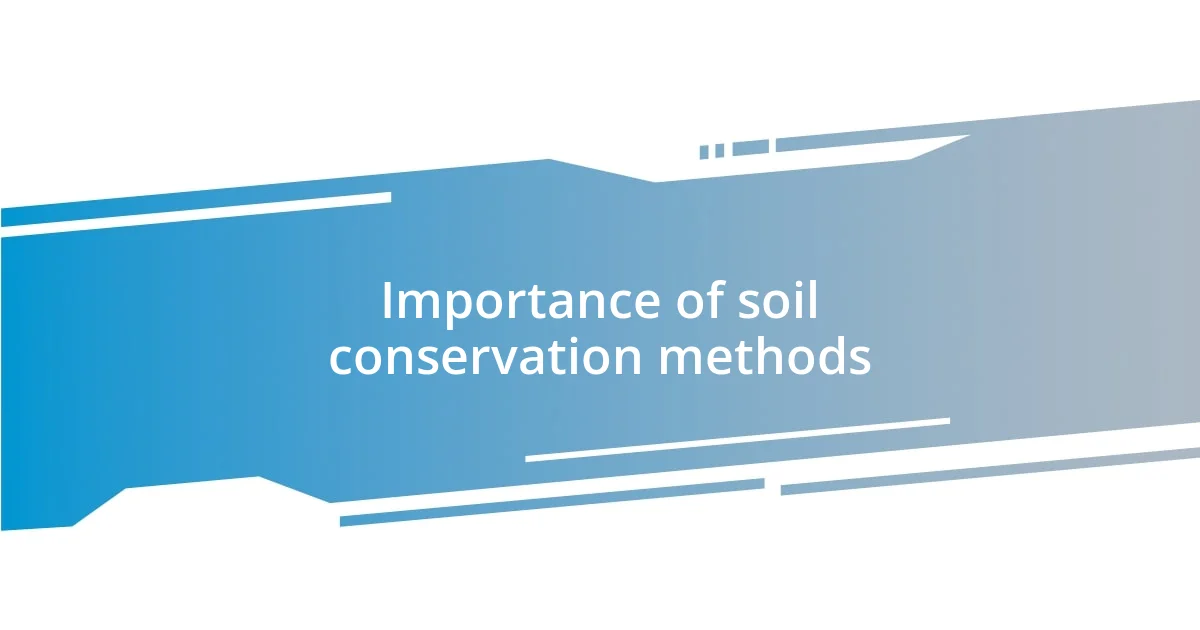
Importance of soil conservation methods
Soil conservation methods are vital for maintaining the health and productivity of our land. I remember attending a local agricultural workshop where farmers passionately discussed their sustainable practices. It struck me how these methods not only protect the soil but also enhance the ecosystem around us. Watching these farmers implement cover crops and contour farming made me realize that when we conserve soil, we are also safeguarding our water supply and supporting biodiversity.
Here are some key reasons why soil conservation methods are essential:
- Preventing erosion: Techniques like terracing and planting vegetation reduce the impact of water and wind, protecting topsoil from being washed or blown away.
- Enhancing fertility: Conservation methods improve soil structure and nutrient retention, which leads to healthier crops and better yields.
- Water retention: Well-managed soil can store more moisture, reducing the need for irrigation and helping during dry spells.
- Promoting biodiversity: Healthy soils support diverse microbial life, which is crucial for nutrient cycling and ecosystem balance.
- Climate regulation: By conserving soil, we help maintain carbon storage in the ground, which can mitigate climate change impacts.
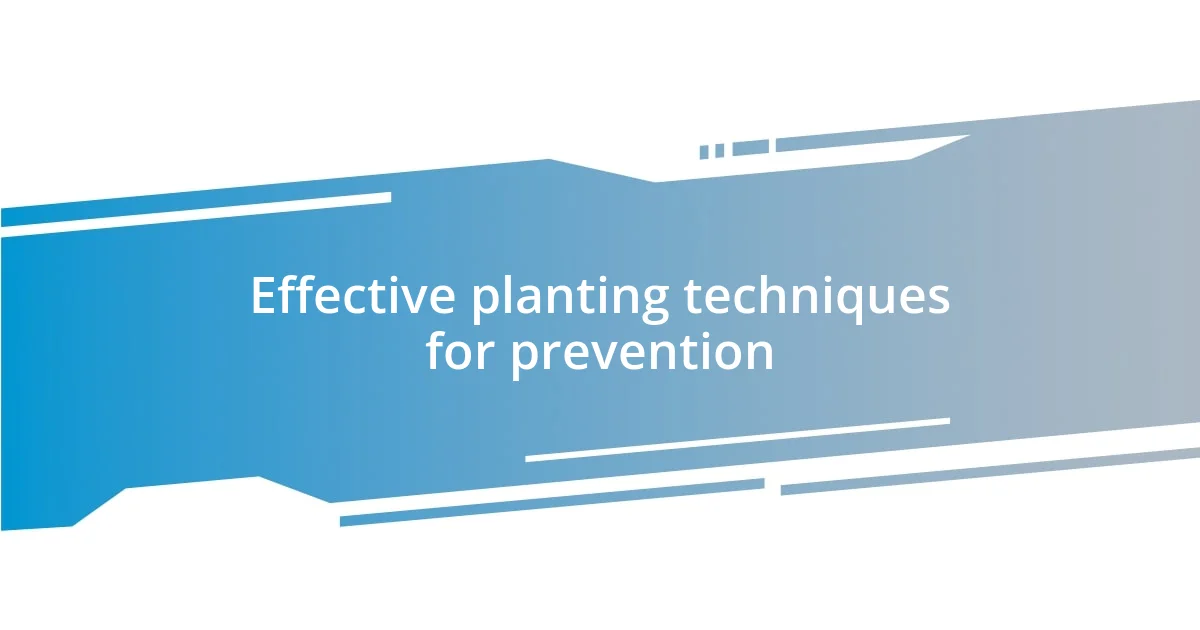
Effective planting techniques for prevention
When it comes to effective planting techniques for soil erosion prevention, I’ve found that strategically planting vegetation is key. I recall a community garden project where we decided to plant native grasses along the slope of a hill. The results were immediate; not only did the grass stabilize the soil, but it also attracted butterflies and bees, making the space vibrant and alive. Isn’t it amazing how a simple planting choice can create a ripple effect in the ecosystem?
Cover crops are another effective technique I’ve personally embraced. A few seasons back, I experimented with planting clover in my vegetable garden during the winter months. When spring came, the soil was enriched and fluffy, and to my surprise, the clover also kept weeds at bay! It’s these experiences that have shown me how beneficial it is to have plants working for you, not just as a barrier against erosion but as essential contributors to soil health.
I can’t overlook the importance of contour farming as well. I remember watching a farmer apply this technique on his hillside fields, planting along the natural contours instead of straight rows. The result was stunning; the horizontal rows acted like mini terraces, significantly slowing down water runoff during rains. It was a real eye-opener to see how nature’s design could be mirrored in our planting practices to achieve practical results.
| Technique | Description |
|---|---|
| Strategic Planting | Utilizing native plants to stabilize soil and promote biodiversity. |
| Cover Cropping | Planting crops like clover in off-seasons to enrich and protect the soil. |
| Contour Farming | Aligning crops with the land’s contours to reduce runoff and enhance moisture retention. |
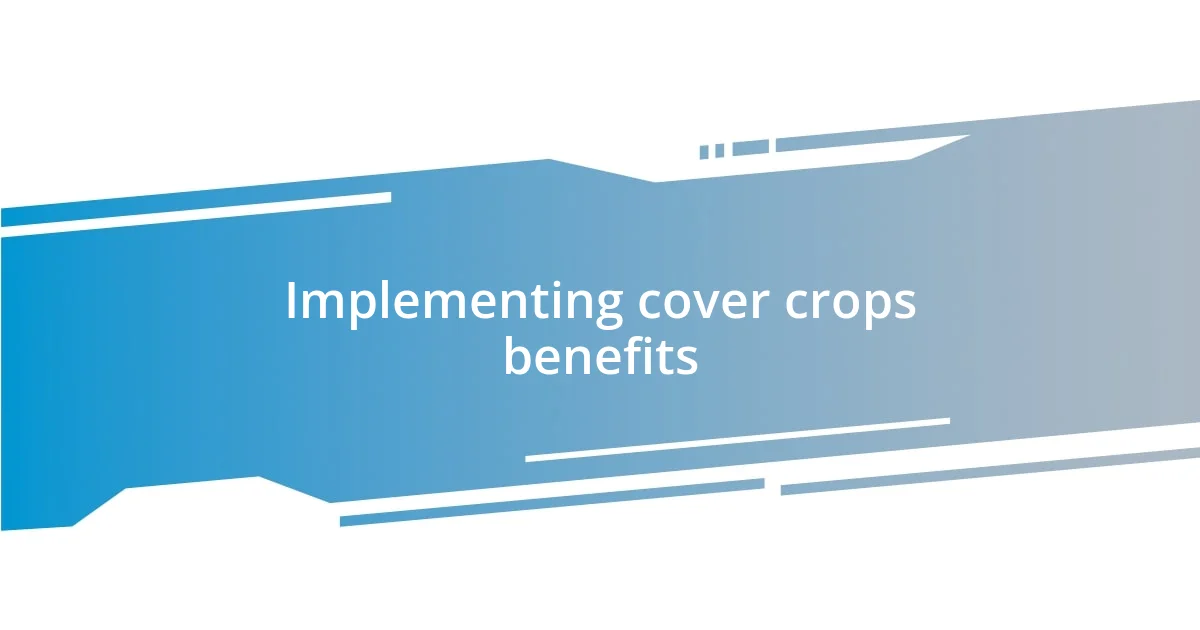
Implementing cover crops benefits
Implementing cover crops has truly transformed my understanding of soil health and erosion prevention. I vividly recall my first attempt at using rye as a cover crop; the way it flourished over winter surprised me. Not only did it protect my soil from erosion, but when spring arrived, I found myself with a treasure trove of organic matter to incorporate into my garden. Watching my plants thrive that season felt like discovering a hidden gem in my gardening journey.
I’ve often marveled at how cover crops can be like a secret weapon in our environmental toolkit. For instance, after a season of planting vetch, I noticed a remarkable difference—the improved soil structure was palpable. It was as if the soil itself had breathed easier. Have you ever dug your hands into freshly amended earth and felt the difference? It’s a tactile reminder of how nature rewards our efforts with richer, healthier soil.
Moreover, the concept of nitrogen fixation is fascinating in this context. I remember speaking to a fellow gardener who swore by planting legumes as cover crops. The excitement in her voice when she explained how these plants could naturally replenish soil nitrogen was contagious. It made me rethink my approach to fertilization; wouldn’t it be great if we could harness nature to do the work for us? Transitioning to cover crops not only fosters healthier ecosystems but allows us to engage with the land in a more sustainable and responsible way.
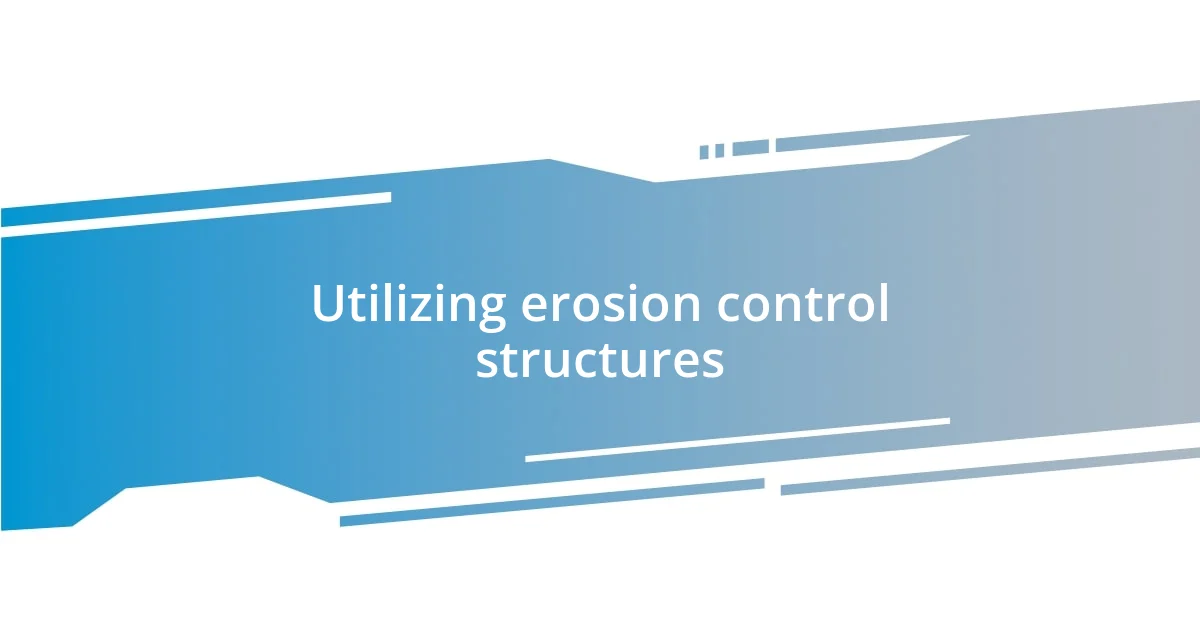
Utilizing erosion control structures
Utilizing erosion control structures can significantly enhance soil stability, particularly in areas prone to runoff. I recall a project where we constructed a series of wooden terraces on a steep slope, and the impact was incredible. Not only did the terraces reduce erosion, but they also created small, flat areas that became perfect for planting flowers and vegetables—who knew they could be so multifunctional?
In situations where I faced heavy rainfall, I found that installing silt fences made a huge difference in capturing sediment. Watching those fences fill with soil while protecting the nearby stream was eye-opening. It felt rewarding to see that my efforts were preventing sediment pollution, making me think—how often do we overlook such simple yet effective solutions in our quest for sustainability?
I also explored using rock structures, like gabions, which provide both support and habitat for wildlife. I remember feeling a sense of accomplishment as I watched small creatures making their homes around the rocks. It made me appreciate how thoughtfully designed erosion control methods can serve dual purposes—protecting soil while enriching biodiversity. Isn’t it fascinating how with a little effort, we can benefit both our gardens and the environment?
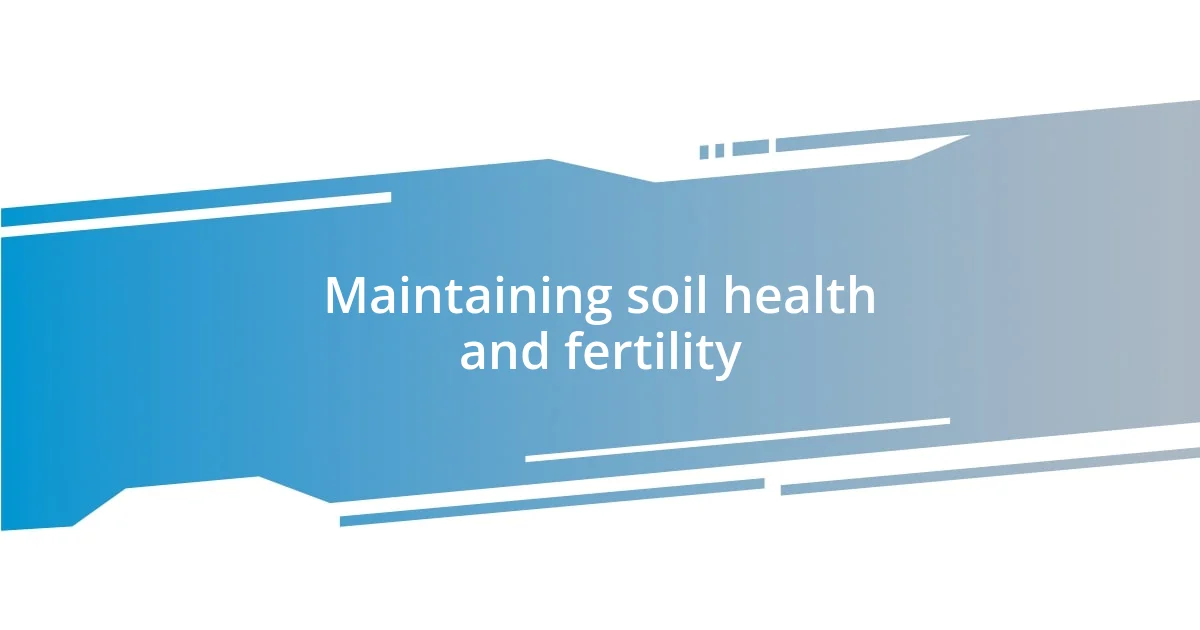
Maintaining soil health and fertility
Maintaining soil health and fertility requires a holistic approach, considering everything from organic matter to microbial life. I remember the first time I started composting kitchen scraps and yard waste. The transformation of those leftovers into rich, dark compost was not only satisfying but also eye-opening—it felt like I was giving back to the earth. Have you ever noticed how vibrant plants seem to grow in a garden that’s had a good dose of homemade compost? It really reinforces the idea that nurturing soil is about creating a living, breathing ecosystem beneath our feet.
In my experience, rotating crops has been a game changer for soil vitality. One year, I decided to switch my tomato patch with beans and was astonished by the improvement. The soil seemed more alive, teeming with earthworms and beneficial microorganisms. It made me realize that growing different plants not only prevents nutrient depletion but also fosters a diverse soil community. Isn’t it intriguing how plants can actually communicate through their roots, sharing resources and supporting one another?
I also emphasize the importance of mulch in my gardening practices. I vividly recall how a thick layer of shredded leaves during summer transformed my garden into a moisture-retentive haven. It not only suppressed weeds but also provided a gradual nutrient release as it broke down. Watching this process unfold reminded me that maintaining soil fertility isn’t just about what we add; it’s also about what we protect and preserve. Isn’t it comforting to know that sometimes the simplest measures can lead to the most significant benefits?
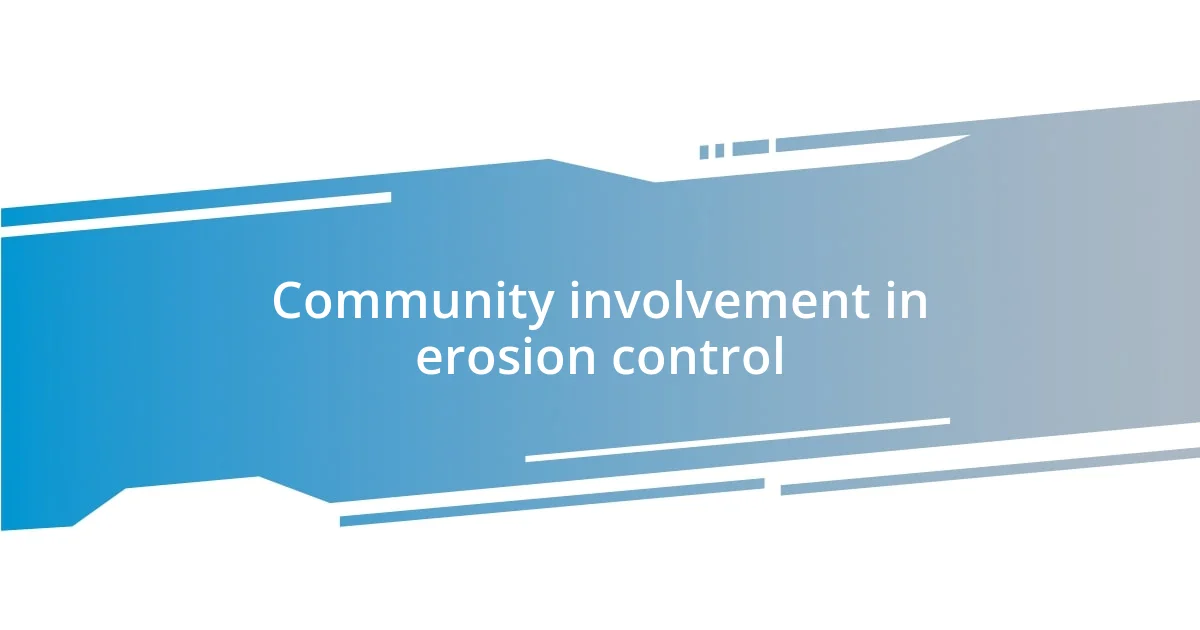
Community involvement in erosion control
Community involvement plays an essential role in erosion control, and I’ve witnessed this firsthand during neighborhood clean-up events. One unforgettable day, we gathered a small group to plant native vegetation along a vulnerable stream bank. As I dug into the earth, feeling the cool soil beneath my hands, I saw our collective effort come to life. It wasn’t just about planting; it felt like we were bonding with nature and each other, ensuring a healthier environment for future generations. Have you ever been part of something that truly invigorated your sense of community?
In my experience, educational workshops can spark enthusiasm among local residents about erosion issues. I participated in a seminar where experts shared the impacts of soil erosion on our region. It really opened my eyes to the broader implications of what I often take for granted. Engaging with the community in learning together was electrifying—it’s amazing how knowledge can drive action and instill a shared responsibility towards our landscape. When was the last time you learned something that changed your perspective?
One of the most impactful initiatives I’ve seen is establishing community gardens. I remember a small group of us decided to create a garden in a neglected lot in our neighborhood. It not only beautified the area but also stabilized the soil and cultivated friendships among diverse groups of people. Watching the children water the plants and learn about the importance of soil health was a heartwarming experience. Isn’t it empowering to think that simple acts of gardening can actively combat erosion while fostering community spirit?


